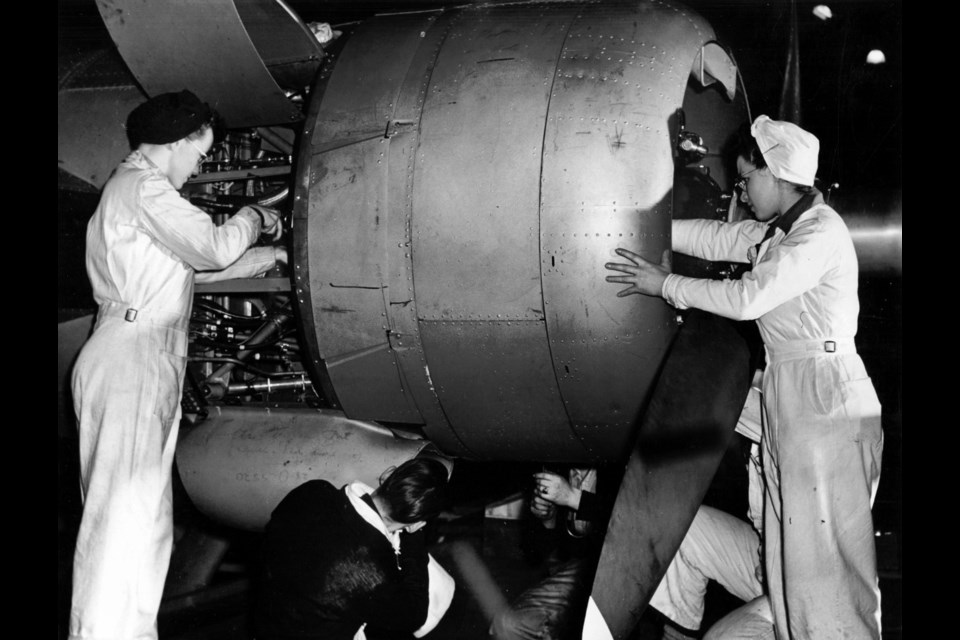To characterize the diminutive community of Burkeville on Sea Island as nothing more than an old, company town would be an understatement. So, too, would be the contribution its people and associated facilities made to the Second World War effort.
For a start, 300 or so cottage-style homes formed Burkeville and was named after Stanley Burke, then president of the Boeing Aircraft company. The Canadian government built the homes to house workers at the nearby production plant who had families.
At the aircraft production plant, a total of 362 U.S. Air Force PBY Catalina flying boats – and the Canso, its Canadian counterpart – were pieced together between 1942 and 1945.
Jack Baryluk, whose entire working career in aviation maintenance has been on Sea Island, is a bit of a local historian. He said Burkeville was a thriving community, almost unto its own.
“It had its own garage, church, and general store. That’s all gone now, but most of the houses remain,” said Baryluk, who up until about a year ago lived in one near the end of YVR’s south runway. It was torn down and replaced with a new home that now offers the former associate dean of BCIT’s aerospace campus, a clear view of air traffic.
“People don’t realize that Boeing Canada produced the Catalinas, as well as hundreds of centre sections for the B-29 bomber, which were sent down to Seattle by train,” he said. “There were 7,000 workers here at its peak. It’s kinda hard to imagine that now. And it’s the reason Burkeville exists.”
So, why was Sea Island chosen?
“The Boeing plant in Seattle was maxed out,” Baryluk said, “and the RCAF needed the aircraft. So, instead of trying to find somewhere in the U.S. to build them, why not employ Canadian workers and build them here.”
But it wasn’t the only aircraft plant that Boeing had in the Lower Mainland back then. There were a total of six others.
“But the production plant here (near YVR’s South Terminal) was the biggest one,” Baryluk said, adding some workers who did not live in Burkeville were bused in on a special Boeing bus from the Marpole area of Vancouver.
According to the Sea Island Heritage Society’s website, the Boeing plant was open seven days a week and Sunday was run on overtime. Workers were only granted half hour lunches and at first, with no breaks. But once a union was established, workers were granted two, 10-minute breaks per shift.
About half of the workforce was made up of women. And all employees were required to purchase their own coveralls and sturdy shoes for the job.
And the women had to wear kerchiefs to keep their long hair from getting caught up in the machinery they were working on.
Since it was wartime, security at such a sensitive site, such as the aircraft plant, was paramount.
On entering or leaving, workers had to not only present their ID card, but open their lunch boxes to ensure nothing was being taken from the premises.
Workers were paid between 40 and 80 cents an hour, which at the time was considered a decent rate.
The aircraft they produced were long-range patrol planes that Canada needed to fly the coastline, Baryluk said.
The majority of the others went to the war in the Pacific where an aircraft of that type helped determine one of the pivotal sea battles in that theatre.
“It was a Catalina that discovered the Japanese fleet at Midway (Island) while doing a high altitude patrol. That allowed the Americans to get the jump on them.”
Soon after the war ended, the Sea Island plant was shut down.
“The provincial government of the day wouldn’t give them a tax break anymore and Boeing pulled out,” Baryluk said. “That’s a sad story, because in other places in Canada where Boeing operated – Manitoba and Ontario – the tax breaks continued. And Boeing still exists there, whereas we don’t have the benefit of a large manufacturer.”
What remains on Sea Island today, in addition the remaining Burkeville homes, is the finishing hangar where the final touches were put on the aircraft before being tested and transported.
Plus, there is a building that was once used for engine testing which is still in place.
Other evidence of Boeing’s presence remains in Vancouver, where the rail shipping yards now house the Vancouver Flea Market on Terminal Avenue.



